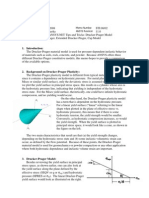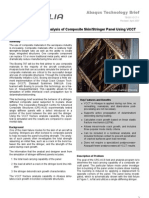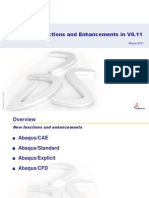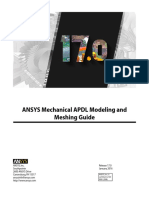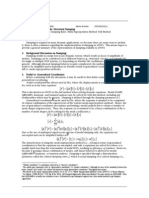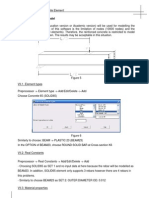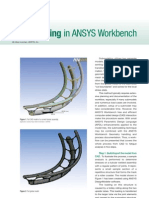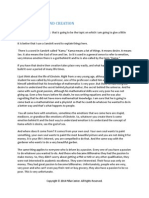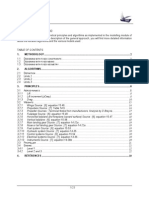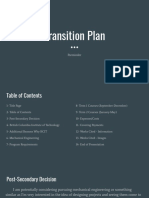Cohesive Zone Modeling
Cohesive Zone Modeling
Uploaded by
Ambalam NandhuCopyright:
Available Formats
Cohesive Zone Modeling
Cohesive Zone Modeling
Uploaded by
Ambalam NandhuOriginal Description:
Copyright
Available Formats
Share this document
Did you find this document useful?
Is this content inappropriate?
Copyright:
Available Formats
Cohesive Zone Modeling
Cohesive Zone Modeling
Uploaded by
Ambalam NandhuCopyright:
Available Formats
1 http://www.nenastran.
com/Composites
NASTRAN COHESIVE ZONE MODELING OF
COMPOSITE BONDED JOINTS
Allan Hsu, Barton McPheeters
NEi Software
5555 Garden Grove Boulevard
Westminster, CA 92683, USA
ABSTRACT
A computationally efficient method for modeling delamination initiation and propagation
in composite bonded joints is presented to aid in aircraft structural analysis. The
modeling strategy incorporates the following state of the art finite element technologies
to accurately capture the complex damage mechanisms in bonded composite joints:
cohesive zone modeling (CZM), three-dimensional layered solid elements, and
micromechanics-based damage degradation. Simulation results are presented for a
Double Cantilevered Beam (DCB) Mode I Fracture Test and a Mixed Mode Skin
Stiffener Tension Test, and compared to experimental data from technical publications.
1. INTRODUCTION
Analytical assessment of composite bonded joints is a recurring issue in aircraft design
today. Various techniques have been applied to this problem with mixed results. Some
techniques involve a two-step approach where a conventional finite element stress
analysis predicts delamination initiation, and the initial debond results are passed to a
fracture mechanics approach for delamination propagation predictions. Other techniques
are not able to fully capture all of the critical components of complex damage
mechanisms: initial damage resulting from through thickness matrix cracking and
branching, matrix cracks driving delaminations to occur, stiffness degradations in fiber
and/or matrix directions, and complete delamination across the adhesive bondline. This
particular one-step modeling strategy is designed to capture the true failure mechanism of
the joint, and incorporates the following state of the art finite element technologies to
accurately capture the complex damage mechanisms in bonded composite joints:
cohesive zone modeling (CZM), three-dimensional layered solid elements, and
micromechanics-based damage degradation. As the micromechanics-based failure model,
MultiContinuum Theory (MCT) is utilized as part of the modeling strategy to extract
separate failure predictions for the fibers and epoxy matrices throughout the composite
joints. Using a Double Cantilevered Beam (DCB) Mode I Fracture Test and a Mixed
Mode Skin Stiffener Tension Test, the paper compares critical delamination propagation
failure loads predicted by NASTRAN with experimental data from previously published
technical publications.
2 http://www.nenastran.com/Composites
1. FINITE ELEMENT METHODS
Cohesive Zone Modeling (CZM) is a generally applicable nonlinear methodology for
simulating crack initiation and crack growth in pure mode and mixed mode fractures. The
incremental growth of a crack due to environmental loading can be monitored from
analysis, and the damage tolerance of the composite structure can be assessed. Many
different delamination scenarios can be analyzed with CZM: delamination in the
adhesive/adherend interface of a bonded joint or delamination in the skin/core interface
of a large scale honeycomb sandwich structure, for example.
Cohesive Zone Elements are typically defined at bonded contact interfaces between
structural elements. The behavior of these Cohesive Zone Elements are governed by
Traction Separation laws shown in Figure 1: as the cohesive zones separate, the traction
first increases until a maximum interfacial allowable stress is reached, then the traction
decreases to zero at a maximum interfacial allowable displacement, which results in
complete local separation. Normal (Mode I) and shear (Mode II) behavior are both
controlled by this triangular Traction Separation law. The area under the triangular curve
is the Strain Energy Release Rate, and this energy dissipation rate can be experimentally
determined for various joints.
Figure 1. Traction Separation Laws of Cohesive Zone Elements
We will use NEi Nastran for the finite element solver, taking advantage of its three-
dimensional layered solid element capability. Like standard layered shell elements, the
layup/stackup for the laminate is defined by the materials, ply thicknesses, and fiber
orientation angles (if applicable) for each layer. A known limitation of layered shell
elements is the usage of beam shear theory to derive balancing transverse shear stresses
3 http://www.nenastran.com/Composites
on a ply by ply basis. Layered solid elements do not have this limitation transverse
shear and the through-thickness normal stresses are included as a direct result of the
triaxial stress state in the fully 3D orthotropic material. The through-thickness stresses are
taken into account to assess fiber failures, matrix cracking, and delamination between the
plies. These stress components are particularly important when the following conditions
are present: thick laminates and joints, out-of-plane loading, or the free edges of a
component are the main regions of concern. With the same number of elements, there is
no computational time penalty for using layered solid elements instead of layered shell
elements. Also, the layered solid elements have three integration points per layer in the
through-thickness direction to ensure accuracy of results.
We will utilize NEi Nastrans embedded MultiContinuum Technology (MCT) capability,
provided by Firehole Composites Helius product. The traditional FEM approach for
fiber reinforced composites is to smear the properties of the fiber and matrix together to
arrive at a homogeneous representation of each layer. The smeared properties can be
found from testing or a micro-mechanical approach. Failure in smeared-layer analyses is
determined using a failure index that relates the stresses and strains in this smeared layer
to experimentally-determined material strengths. The micromechanics-based MCT
separates the matrix and fiber properties, handling each composite constituent differently
and allowing failure to progress through a multi-step damage mechanism. For example,
compression of a composite often results in the matrix being squeezed around with
deformations due to the Poissons effect that drag the fibers with them. With the matrix
and fibers in different stress states, the composite laminate can be much closer to failure
than a smeared approach would predict. Effects like this can become significant
especially when thermal loads are added to structural ones. Failure theories like Puck [5]
and LARC02 [1] account for the different failure states of the fibers and matrix. They
predict a two-step failure, with matrix (or possibly fiber) failing first, followed later by
the other with a subsequent degradation of properties in the interim. MCT accounts for
multiple-step failure, as well as out-of-plane stresses. Out-of-plane stresses can
sometimes be a significant fraction of in-plane stresses, up to the point that the matrix can
fail in the out-of-plane direction before the in-plane directions have failed completely.
MCT also has the major advantage of being developed for weaves/fabrics and other
composites (metal matrix, long fiber, unaligned fiber, etc.), while LARC02 and PUCK
was developed strictly for unidirectional composite materials. Fertig provides the
equations used to implement MCT [3].
Progressive Ply Failure Analysis allows a composite to fail one ply at a time. Once an
iterative nonlinear model is setup (either nonlinear static or nonlinear transient dynamic),
a Progressive Ply Failure Analysis can be run to examine the progression of nonlinear
damage. The selected Failure Theory predicts when a particular ply will fail, and then the
stiffness of the failed directions will be reduced with the corresponding reduction scale
factor (10 percent is used for this investigation). Multiple papers have shown Progressive
Ply Failure Analysis results to not be very sensitive to the exact value of the stiffness
reduction scale factors varying the reduction scale factors from 4-20 percent generally
affect the composite FEA results minimally. Equilibrium is reestablished after the
material properties are degraded, and then at the next time step/load increment, composite
4 http://www.nenastran.com/Composites
stresses are again checked to see what plies and what direction the plies fail in. After the
nonlinear analysis is concluded, the analyst can postprocess output such as percentage of
plies failed and location of plies failed.
2. DOUBLE CANTILEVERED BEAM MODE I FRACTURE TEST
2.1 Lamina Properties
The laminate for the Double Cantilevered Beam (DCB) tests are prepared from a carbon
(T300)/toughened epoxy (977-2) prepreg supplied by Cytec Fiberite.
Table 1. Material Properties for T300/977-2 Carbon Fiber
2.2 Finite Element Model Details
A DCB FEM is constructed to explore the delamination propagation through a bonded
joint with a starter crack see Figure 2. The carbon fiber laminate has a stackup of [0]
24
,
and has dimensions of 150mm long, 20 mm wide, and 4 mm thick. The starter crack is 55
mm long.
Enforced displacement in the +Z/-Z direction is applied to the top edge of the top beam
and the bottom edge of the bottom beam to enable a Mode I opening type fracture. Using
6 CHEXA (linear hexahedral solid elements) elements through the thickness, a total of
3600 CHEXA elements form the mesh. The elements are not connected in any fashion at
the initial precrack locations, and cohesive zone elements are specified at the bonded
contact interface.
For the triangular Cohesive Zone Law, the Strain Energy Release Rate is related by:
(1)
5 http://www.nenastran.com/Composites
SDMAXT is the interfacial allowable stress, and UDMAXT is the interfacial allowable
displacement. Multiple combinations of SDMAXT and UDMAXT were iterated on to
fulfill the requirement of SERR = 0.3 N/mm [2]. For most combinations of SDMAXT
and UDMAXT, FEA results were similar and not very sensitive. SDMAXT of 20 MPa
and UDMAXT of 0.03 mm were found to provide good nonlinear convergence and
correlate to experimental data well. Lowering SDMAXT and increasing UDMAXT
usually helps with nonlinear convergence. Lowering SDMAXT excessively will result in
significantly altered results.
Progressive damage (PPFA) of the carbon fibers and epoxy matrices are ignored for this
simulation.
Figure 2. DCB Finite Element Model with Cohesive Zone Elements
2.3 DCB Mode I Fracture Results
Nonlinear static analysis (Nastran SOL 106) is run with large displacement effects that
include follower forces and differential stiffness.
The laminate opens up in a pretty stable manner see Figure 3. The red regions indicate
locations where the cohesive zones have completely failed and the adhesive is no longer
functional.
Figure 3. Deformed Configuration of DCB (1:1 Actual Def)
6 http://www.nenastran.com/Composites
Figure 4. Results Comparison Simulation vs. Experiment
Delamination initiates at a certain critical load (P Crit), and as the delaminations
propagate through the adhesive bondline, the stiffness of the DCB decreases.
Looking at Figure 4, the simulation results have good correlation with the experimental
and analytical results. The critical delamination failure load from experiment is 58 N, and
the failure load from Node 153 in the simulation is 53.6 N. The experimental results are
taken from De Morais, et a. [2], and is a typical load-displacement curve from the
testing. A critical load (P Crit) was also calculated to be 63.7 N through analytical
relations these calculations are not presented here.
Nodes 151-155 are the 5 loaded nodes on the edge of the top beam (153 is in the center of
the edge, 152 and 154 are next to 153, 151 and 155 are on the ends of the edge). Nodes
151 and 155 have the same load-displacement response, while nodes 152 and 154 have
the same load-displacement response.
Load-displacement response is plotted for all 5 nodes to show the variance of behavior
through the width of the specimen. Experimental testing has shown that at the crack tip in
DCB specimens, the Strain Energy Release Rate decreases close to the edges. The
maximum load for the ends of the edge (Nodes 151 and 155) is 39.7 N.
7 http://www.nenastran.com/Composites
3. MIXED MODE SKIN STIFFENER TENSION TEST
3.1 Lamina Properties
Both skin and flange are made from IM6/3501-6 graphite/epoxy prepreg tape with a
nominal thickness of 0.188 mm. Along with lamina material properties, constituent (fiber
and matrix) material properties are also input into the finite element simulation for use
with the MCT micromechanical failure model.
Table 2. Material Properties for IM6/3501-6 Carbon Fiber [4]
3.2 Finite Element Model Details
A bonded skin and flange assembly FEM is constructed to explore the complex damage
mechanism of a complete delamination of a composite flange see Figure 5. The skin
layup, consisting of 14 plies, is [0/45/90/-45/45/-45/0]
S
, and the flange layup, consisting
of 10 plies, is [45/90/-45/0/90]
S
. The skin width is 25.4 mm, and the skin length is 127.0
mm. Maximum flange length at the adhesive bond is 50 mm, and the minimum flange
length is 42 mm. The angle at the flange tip is 27 degrees.
8 http://www.nenastran.com/Composites
One side of the composite skin is constrained in X, Y, and Z translations. The other side
is constrained transversely (Y and Z directions) and enforced to displace in the +X
direction. Using 2 CHEXA (linear hexahedral solid elements) elements through the
thickness for both the skin and the flange, a total of 828 layered solid elements form the
mesh. Cohesive Zone Elements are specified for the bonded contact interface between the
flange and the skin. The two tapered flange ends are meshed differently to prevent
simultaneous delamination from occurring at both ends.
For Mode I opening mode, SDMAXT is set to 11.3 MPa and UDMAXT is set to 0.0162
mm to satisfy SERR = 0.0931 N/mm [4]. For Mode II shearing mode, SDMAXS is set to
11.3 MPa and UDMAXS is set to 0.084 mm to satisfy SERR = 0.467 N/mm. For these
types of CZM simulations, experience suggests we use a realistic value for interfacial
allowable stresses and then adjust, if needed, to improve convergence.
Micromechanics based damage degradation is utilized in this simulation.
Figure 5. Bonded Skin and Flange FEM
3.3 Skin Stiffener Tension Test Results
3.3.1 Displacement-Load Behavior
Nonlinear static analysis (Nastran SOL 106) is run with large displacement effects that
include follower forces and differential stiffness. NEi Nastrans layered solid element and
MultiContinuum Theory (MCT) capabilities add virtually zero computational penalty to a
typical nonlinear finite element run the biggest factor for run time is model size
(number of degrees of freedom) and number of cohesive zone elements. The system is
setup for large complex multiscale composite models, with simultaneous in-plane and
out-of-plane damage progression, to run within hours. This particular analysis ran
through 392 load increments, 9 load bisections, and 1625 equilibrium iterations in about
half an hour (depending on hardware used).
The displacement-load curve stays linear until matrix cracking occurs at the flange tip,
which quickly propagates into debond failures along the adhesive bondline. A load drop
occurs as the flange completely and unstably separates from the composite skin. In Figure
6, the x-axis is the displacements in the X direction extracted at the flange tip, and the y-
axis is the total load applied in the X direction at the enforced motion boundary.
9 http://www.nenastran.com/Composites
Figure 6. Displacement-Load Behavior of Skin Stiffener FEM
Five tension tests were performed by Krueger [4]; the FE simulation results are tabulated
with the experimental data in Figure 7. The correlation is good - the damage initiation
load and flange debond load is slightly lower for the FE simulation, but for both
simulation and test, damage initiation occurs at or above 90 % of flange debond load. It is
interesting to note that for one test specimen, no visible damage could be detected prior to
flange debond at 21,100 N.
Figure 7. Results Comparison Simulation vs. Experiment
10 http://www.nenastran.com/Composites
3.3.2 Bond Failures and Matrix Failures
From Figure 8, it is observed that the specimen is elongated by the tensile load, but also
bends due to the local effects of the flange. The locations of matrix cracking and
branching, after the complete separation of flange from skin, are shown in Figure 10. The
delaminated bondline regions are shown in Figure 9.
Figure 8. Deformed Configuration at Damage Initiation (10 to 1 Actual Def)
Figure 9. Delamination Failure Regions
Figure 10. Matrix Failure Regions
11 http://www.nenastran.com/Composites
3.3.3 Assessing Probability of Fiber Damage
From using the micromechanics-based failure model MCT for damage degradation, we
can extract matrix-specific and fiber-specific failure indices for the laminated structure at
any load level. For example, at damage initiation load, matrix failure indices and fiber
failure indices for all the plies are shown in Figures 11 and 12. Using this type of
constituent-based information, the analyst can conclude that at damage initiation load, the
fibers are not close to being damaged with a max Fiber FI of 0.22. Also, with the flange
tips cracking, most of the flange exhibits matrix failure indices less than 0.1. The matrix
cracking that occurs is in the through-thickness direction, and the middle of the
composite flange does not experience much load.
Figure 11. Matrix Failure Indices at Damage Initiation
12 http://www.nenastran.com/Composites
Figure 12. Fiber Failure Indices at Damage Initiation
4. CONCLUSIONS
Composite bonded joints historically have been difficult to analyze for structural integrity
and damage tolerance, and current aerospace programs have needed to depend heavily on
expensive experimental testing to catch design flaws.
An integrated Finite Element Analysis solution in the NASTRAN environment has been
proposed for aerospace engineers to efficiently and accurately optimize complex
composite structures. The combination of Cohesive Zone Modeling with 3D
micromechanics based damage degradation offers invaluable design insight into the
complex damage mechanism of composite bonded joints.
For the test cases described in this paper, DCB Mode I Fracture Test and Skin Stiffener
Tension Test, NASTRAN has proved to be fairly accurate in predicting critical
delamination propagation failure loads. The failure load for DCB Mode I Fracture Test is
predicted within 10 % of experiment, and the failure load for Skin Stiffener Tension Test
is predicted within 20 % of experiment.
Future research will focus on using this same coupling of in-plane and delamination
simulation to model advanced dynamic load events Barely Visible Impact Damage
(BVID) and high speed ballistic impacts.
13 http://www.nenastran.com/Composites
5. REFERENCES
1. Dvila, C.G., Jaunky, N., and Goswami, S. Failure Criteria for FRP Laminates in
Plane Stress. 44th AIAA/ASME/ASCE/AHS Structures, Structural Dynamics, and
Materials Conference, Norfolk, Virginia, 7-10 April 2003.
2. De Morais, A.B., De Moura, M.F., Marques, A.T., De Castro, P.T., Mode-I
Interlaminar Fracture of Carbon/Epoxy Cross-Ply Composites. Composites Science
and Technology 2002;62:679-686.
3. Fertig, Ray S. III, Bridging the Gap Between Physics And Large-Scale Structural
Analysis: A Novel Method For Fatigue Life Prediction Of Composites 2009 SAMPE
Fall Technical Conference, Wichita, Kansas, 19-21 October 2009.
4. Krueger, R., M. K. Cvitkovich, T. K. OBrien, and P. J. Minguet, Testing and
Analysis of Composite Skin/Stringer Debonding under Multi-Axial Loading,
Journal of Composite Materials, vol. 34, no. 15, pp. 1263-1300, 2000.
5. Puck, A. and Schrmann, H. Failure analysis of FRP laminates by means of
physically based phenomenological models. Composites Science and Technology,
62:12-13 (2002) 1633-1662.
You might also like
- Abaqus Explicit VUMAT For HysteresisDocument5 pagesAbaqus Explicit VUMAT For HysteresisAnastasios Karahalios100% (1)
- Elexia Comfort enDocument4 pagesElexia Comfort enJózsef HollendusNo ratings yet
- Earthing and Lightning SolutionDocument20 pagesEarthing and Lightning SolutionZhizhao Oon100% (1)
- Step by Step Procedure To Export A Deformed Geometry in AnsysDocument11 pagesStep by Step Procedure To Export A Deformed Geometry in AnsysvilukNo ratings yet
- Total NAS102Document363 pagesTotal NAS102Alejandro Palacios MadridNo ratings yet
- STI0802 Drucker PragerDocument4 pagesSTI0802 Drucker Pragertinchofran100% (1)
- Preventing Negative Volume 2010-10Document9 pagesPreventing Negative Volume 2010-10Gustavo Yippeekayyay GusNo ratings yet
- Venturi ScrubberDocument16 pagesVenturi ScrubbersandikshaNo ratings yet
- CAE Fatigue and Fracture Seminar - CZM For WebDocument21 pagesCAE Fatigue and Fracture Seminar - CZM For WebdamnkaushikNo ratings yet
- Introduction to the Explicit Finite Element Method for Nonlinear Transient DynamicsFrom EverandIntroduction to the Explicit Finite Element Method for Nonlinear Transient DynamicsNo ratings yet
- Guidelines For Coheseive Parameters Ebook 3Document11 pagesGuidelines For Coheseive Parameters Ebook 3arkan1976100% (1)
- RBE2Document20 pagesRBE2zakir78No ratings yet
- Subroutine For Cohesive ElementDocument41 pagesSubroutine For Cohesive ElementBhushanRaj100% (1)
- COMSOL Cohesive Zone DebondingDocument22 pagesCOMSOL Cohesive Zone DebondingAaqib AliNo ratings yet
- Strength of LugDocument8 pagesStrength of LugnareniviNo ratings yet
- Surface To Surface ContactDocument13 pagesSurface To Surface ContactscribddisantoNo ratings yet
- Crippling Analysis of Composite Stringers PDFDocument9 pagesCrippling Analysis of Composite Stringers PDFDhimas Surya NegaraNo ratings yet
- Ansys Advanced Analysis Techniques GuideDocument346 pagesAnsys Advanced Analysis Techniques GuideSimion LaurentiuNo ratings yet
- Ls Dyna ThLs Dyna TheoryeoryDocument498 pagesLs Dyna ThLs Dyna TheoryeoryxxleonardNo ratings yet
- LS-DYNA Concrete MaterialDocument3 pagesLS-DYNA Concrete MaterialaktcNo ratings yet
- VCCT For Abaqus PDFDocument14 pagesVCCT For Abaqus PDFFelipe Dornellas SilvaNo ratings yet
- APDL HelpDocument220 pagesAPDL HelpFaisal Naveed SiddiquiNo ratings yet
- Fatigue PolymersDocument1 pageFatigue PolymersglihkrNo ratings yet
- LS-DYNA AnalysisDocument29 pagesLS-DYNA AnalysisJohn TerryNo ratings yet
- Nonlinear Nite Element Modeling of RC Beams Strengthened With NSM FRP RodsDocument11 pagesNonlinear Nite Element Modeling of RC Beams Strengthened With NSM FRP RodsRosNo ratings yet
- Get Cracking With ANSYS Workbench 19.2 - Digital Engineering 24 - 7Document15 pagesGet Cracking With ANSYS Workbench 19.2 - Digital Engineering 24 - 7Sujay BhattacharyaNo ratings yet
- Progressive Failure Analysis of Composite Materials Using The PucDocument87 pagesProgressive Failure Analysis of Composite Materials Using The PucMansingh YadavNo ratings yet
- Buckling and Fracture Analysis of Composite Skin-Stringer Panel Using Abaqus and VCCT 2005Document5 pagesBuckling and Fracture Analysis of Composite Skin-Stringer Panel Using Abaqus and VCCT 2005SIMULIACorpNo ratings yet
- Czm-On The Practical Application of The Cohesive ModelDocument25 pagesCzm-On The Practical Application of The Cohesive ModelAldyansyah PutraNo ratings yet
- Imp-Thoupal 2009-Mechanics of Mechanically Fastened Joints in Polymer-Matrix Composite Structures - A Review PDFDocument29 pagesImp-Thoupal 2009-Mechanics of Mechanically Fastened Joints in Polymer-Matrix Composite Structures - A Review PDFJamalDilferozNo ratings yet
- A Material Model For Flexural Crack Simulation in Reinforced Concrete Elements Using AbaqusDocument5 pagesA Material Model For Flexural Crack Simulation in Reinforced Concrete Elements Using AbaqusBala SubramanianNo ratings yet
- Finite Element Analysis Using ANSYS Mechanical APDL & WorkbenchDocument3 pagesFinite Element Analysis Using ANSYS Mechanical APDL & WorkbenchnapinnvoNo ratings yet
- Johnson-Cook Empirical ModelsDocument14 pagesJohnson-Cook Empirical ModelsSanaan Khan95% (22)
- Application of User Defined Subroutine U PDFDocument58 pagesApplication of User Defined Subroutine U PDFmatmean100% (2)
- Models - Sme.cohesive Zone DebondingDocument18 pagesModels - Sme.cohesive Zone DebondingAlireza AzarioonNo ratings yet
- Spin Softening N Stress StiffeningDocument23 pagesSpin Softening N Stress StiffeningaruatscribdNo ratings yet
- Examples of Concrete Element SOLID65 - Hani Aziz AmeenDocument46 pagesExamples of Concrete Element SOLID65 - Hani Aziz AmeenHani Aziz AmeenNo ratings yet
- WS02 Solid To Solid ContactDocument20 pagesWS02 Solid To Solid ContactL.a. Mayor100% (1)
- Abaqus New Function in V6.11Document121 pagesAbaqus New Function in V6.11DS AlfonsoNo ratings yet
- Rubber Visco SummaryDocument19 pagesRubber Visco Summaryrufus728No ratings yet
- Time Step Size - LS-DYNA Support PDFDocument4 pagesTime Step Size - LS-DYNA Support PDFHemanth SarabuNo ratings yet
- ANSYS Mechanical APDL Modeling and Meshing GuideDocument242 pagesANSYS Mechanical APDL Modeling and Meshing GuideSPUTNIKNo ratings yet
- Simulation Explosive Impact On The Structure in LS-DYNA 1Document8 pagesSimulation Explosive Impact On The Structure in LS-DYNA 1heltaherNo ratings yet
- 02 Radioss SEAT BELT ANCHORAGE RADIOSS PAPER Eicher Polaris PDFDocument6 pages02 Radioss SEAT BELT ANCHORAGE RADIOSS PAPER Eicher Polaris PDFsurya prakashjNo ratings yet
- Automotive NVH With AbaqusDocument17 pagesAutomotive NVH With Abaquspatran74No ratings yet
- Ls Dyna Ls Prepost TutorialDocument33 pagesLs Dyna Ls Prepost TutorialAgus Wijaya0% (1)
- ANSYS DampingDocument8 pagesANSYS Dampingsuresh_501No ratings yet
- Lsdyna User GroupDocument11 pagesLsdyna User GroupPunith MlNo ratings yet
- Damage and Failure For Ductile MetalsDocument10 pagesDamage and Failure For Ductile Metalsp_rameshreddy2006No ratings yet
- Simplified ANSYS Model Concrete CrackDocument10 pagesSimplified ANSYS Model Concrete CrackMohamadreza Seraji100% (3)
- Sub Modeling in ANSYS WorkbenchDocument3 pagesSub Modeling in ANSYS Workbenchchandru20No ratings yet
- Abaqus Technology BrifDocument6 pagesAbaqus Technology BrifFARZADFGNo ratings yet
- Damage Mechanics in Metal Forming: Advanced Modeling and Numerical SimulationFrom EverandDamage Mechanics in Metal Forming: Advanced Modeling and Numerical SimulationRating: 4 out of 5 stars4/5 (1)
- Probabilistic Physics of Failure Approach to Reliability: Modeling, Accelerated Testing, Prognosis and Reliability AssessmentFrom EverandProbabilistic Physics of Failure Approach to Reliability: Modeling, Accelerated Testing, Prognosis and Reliability AssessmentNo ratings yet
- Numerical Simulation of Mixedmode Progressive Delamination in Composite MaterialsDocument24 pagesNumerical Simulation of Mixedmode Progressive Delamination in Composite Materials蕭佩杰No ratings yet
- FB 240615034148Document96 pagesFB 240615034148紀俞揚No ratings yet
- Aiaa 2005 2320 744Document21 pagesAiaa 2005 2320 744Junghyun AhnNo ratings yet
- Tuazon, Christian Jay G PDFDocument11 pagesTuazon, Christian Jay G PDFBryan YuNo ratings yet
- Pstruct 2010 06 011 PDFDocument32 pagesPstruct 2010 06 011 PDFantonellodelreNo ratings yet
- Fracture Analysis of Adhesive Joints Using Intrinsic Cohesive Zone ModelsDocument8 pagesFracture Analysis of Adhesive Joints Using Intrinsic Cohesive Zone ModelsMin-Sung KimNo ratings yet
- Progressive Fracture of Composite Structures: NASA Glenn Research Center, Cleveland, OH 44135Document11 pagesProgressive Fracture of Composite Structures: NASA Glenn Research Center, Cleveland, OH 44135杨肇通No ratings yet
- Fatigue Analysis of Ball JointDocument21 pagesFatigue Analysis of Ball JointAmbalam NandhuNo ratings yet
- The Secret Behind CreationDocument2 pagesThe Secret Behind CreationAmbalam NandhuNo ratings yet
- Optimization BookDocument208 pagesOptimization BookAmbalam Nandhu100% (1)
- Esigning With Fixed Constraints Esigning With Fixed Means Esigning With Fixed GeometryDocument23 pagesEsigning With Fixed Constraints Esigning With Fixed Means Esigning With Fixed GeometryAmbalam NandhuNo ratings yet
- Aircraft Structural Analysis Notes 2Document34 pagesAircraft Structural Analysis Notes 2mdaashuNo ratings yet
- BAOLI Forklift KBG15-20 Operator's ManualDocument95 pagesBAOLI Forklift KBG15-20 Operator's ManualSARAMQR100% (1)
- AC Hotels by Marriott Design Standards Module 15 HVACDocument12 pagesAC Hotels by Marriott Design Standards Module 15 HVACIan OsorioNo ratings yet
- JatNis JF011E VBL - Interactive CVTDocument1 pageJatNis JF011E VBL - Interactive CVTmohamed abd el razekNo ratings yet
- Maxi-Flush - Screen Filters: Product SpecificationsDocument1 pageMaxi-Flush - Screen Filters: Product SpecificationsRiego Fertirrigacion Riego SustentableNo ratings yet
- Work and Energy Review LabDocument1 pageWork and Energy Review LabJane MaranionNo ratings yet
- Westok A5 Pocket Guide Jan 2016Document36 pagesWestok A5 Pocket Guide Jan 2016vomawew647No ratings yet
- Metallurgy Lab Viva VoiceDocument3 pagesMetallurgy Lab Viva VoiceHARIMETLYNo ratings yet
- X PGNDP0464 03 ECI SPC 020 Control Valve Specification RevADocument7 pagesX PGNDP0464 03 ECI SPC 020 Control Valve Specification RevAgrantNo ratings yet
- Retrofit Solutions: Technical DatabookDocument42 pagesRetrofit Solutions: Technical DatabookSanjayNo ratings yet
- Tunnelling and Underground Space Technology: Kyoung-Yul Kim, Dae-Soo Lee, Jaeyeon Cho, Sang-Seom Jeong, Sungjune LeeDocument12 pagesTunnelling and Underground Space Technology: Kyoung-Yul Kim, Dae-Soo Lee, Jaeyeon Cho, Sang-Seom Jeong, Sungjune LeeKen LiewNo ratings yet
- Atriot: Technical Data SheetDocument1 pageAtriot: Technical Data Sheetazeem bilalNo ratings yet
- 068 - ME8351, ME6302 Manufacturing Technology I - Important QuestionsDocument1 page068 - ME8351, ME6302 Manufacturing Technology I - Important QuestionsMr. T. Anjaneyulu Mr. T. AnjaneyuluNo ratings yet
- Tds-Manual DamperDocument4 pagesTds-Manual Dampersabir hussainNo ratings yet
- StrengthDocument74 pagesStrengthAdrianKarlBonaNo ratings yet
- Trane Cgan 7000Document32 pagesTrane Cgan 7000Youghourthen Hendel100% (1)
- 08-Heat ExchangersDocument25 pages08-Heat ExchangersMhelveneNo ratings yet
- Gas Turbine Efficiency and Ramp Rate Improvement Through Compressed Air InjectionDocument19 pagesGas Turbine Efficiency and Ramp Rate Improvement Through Compressed Air Injectionlucas christianNo ratings yet
- Stringer SizingDocument19 pagesStringer SizingRODRIGO MARTIN ORTIZNo ratings yet
- A7 Esquemática InglésDocument25 pagesA7 Esquemática InglésFelix VelasquezNo ratings yet
- Gujarat Technological University: % WeightageDocument4 pagesGujarat Technological University: % WeightageEr Samkit ShahNo ratings yet
- Khushi Report3Document4 pagesKhushi Report3Khushi YadavNo ratings yet
- Caliper Presentation Pig LauncherDocument34 pagesCaliper Presentation Pig LauncherMix VichaitanapatNo ratings yet
- Floor PlanDocument71 pagesFloor PlanTitsuya YurikoNo ratings yet
- Transition PlanDocument14 pagesTransition Planapi-572616954No ratings yet
- Relee Si SiguranteDocument15 pagesRelee Si SiguranteMatei NicolaeNo ratings yet
- 2D - M082245 BXC-1-3 7a PDFDocument1 page2D - M082245 BXC-1-3 7a PDFchirag ramanujNo ratings yet
- 29-Horizontal Subsea Xmas Tree enDocument2 pages29-Horizontal Subsea Xmas Tree encarthik_rajaNo ratings yet





